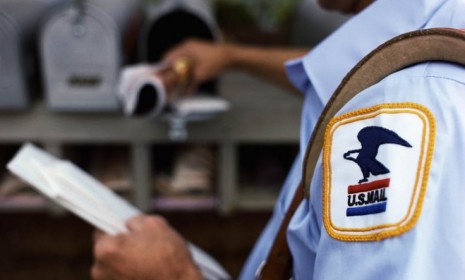Is the Postal Service doomed?
The USPS announces that it may close 12 percent of its local branches — hinting that snail mail could be crawling to its demise

The struggling United States Postal Service announced Tuesday that it is considering shuttering 3,653 local post offices around the country. That means slightly more than one in 10 branches may be closed nationwide. Indeed, it may be time to "start writing a sad, long obituary" for snail mail, says David Magee at International Business Times. How will the closings work, and is this really the end of the USPS? Here, a brief guide:
Is my post office going to close?
Not yet. The 3,653 low-performing local offices are just being flagged for review — for now. "Coming under review doesn't necessarily mean an office will close," says Randolph E. Schmid for the Associated Press. The offices that are being evaluated all suffer from low volumes of business. Most are located in rural areas, though branches at New York City's Port Authority and even the U.S. Capitol are facing review. (A state-by-state list of branches can be found here.) Decisions will be made in 60 days, and in the meantime, customers served by the branches can submit comments. The last time the agency announced it would review offices, more than 50 percent remained open after evaluation.
The Week
Escape your echo chamber. Get the facts behind the news, plus analysis from multiple perspectives.

Sign up for The Week's Free Newsletters
From our morning news briefing to a weekly Good News Newsletter, get the best of The Week delivered directly to your inbox.
From our morning news briefing to a weekly Good News Newsletter, get the best of The Week delivered directly to your inbox.
If my post office closes, how will I send mail?
Communities where branches end up closing might get what's called a "Village Post Office," according to Postmaster General Patrick Donahoe. These are smaller automated kiosks or outposts at local vendors that sell stamps and flat-rate boxes. Some of these mini post offices may even get P.O. box services, says Schmid. For "more complex" transactions — like applying for a passport — customers will just have to travel farther to the nearest full-service branch.
How bad are the Postal Service's troubles?
A decade ago, there were 38,000 post office outlets, says Magee. Currently, there are only 31,000. Last year alone, the Postal Service lost $8 billion. Closing some of the underperforming branches could save up to $200 million a year in labor and operation costs, says Angela Greiling Keane at Bloomberg.
A free daily email with the biggest news stories of the day – and the best features from TheWeek.com
So is this the end?
"Nobody needs the post office like they used to," says Magee. From email to to web advertising to online bill paying, most first-class mail has moved to the internet. And after sharp reductions in USPS staff, a request for relief from its annual $5.5 billion payment to future retiree health benefits, and now the possible mass branch closings, this seems like "the beginning of the end."
Can anything be done to save snail mail?
"It's no secret that the Postal Service is looking to change the way we do a lot of things," says Postmaster General Donahoe, adding that he feels the agency is "still relevant." At the very least, we could slow USPS's decline, says Chris Good at The Atlantic. Ending Saturday delivery would save $3.1 billion a year. Scrapping collective bargaining could lower USPS employment costs, and allowing post offices to perform other services — like voter registration and driver's license renewal — would help them remain relevant.
Sources: Associated Press, Atlantic, Bloomberg, Intl. Bus. Times, NPR
-
 A running list of the US government figures Donald Trump has pardoned
A running list of the US government figures Donald Trump has pardonedin depth Clearing the slate for his favorite elected officials
-
 Ski town strikers fight rising cost of living
Ski town strikers fight rising cost of livingThe Explainer Telluride is the latest ski resort experiencing an instructor strike
-
 ‘Space is one of the few areas of bipartisan agreement in Washington’
‘Space is one of the few areas of bipartisan agreement in Washington’Instant Opinion Opinion, comment and editorials of the day